The Mughals were a powerful Turkic-Mongol tribe that originated from Central Asia.[1] The Mughal Empire controlled most of Northern India from the 16th to the 18th century.[2] The Mughal’s are well known for their effective administrative organization that aided them in ruling much of India for more than two centuries.[3] They are also notable for their attempt to integrate Muslims and Hindus under one united Indian state[4] (more information on this aspect of the Mughal Empire will follow). This article will discuss: the Rise of the Mughal Empire, Government and Society, the Role of Women, Architecture and Culture, Astronomy and Technology, Travel and Trade, and finally, the Decline of the Mughal Empire.
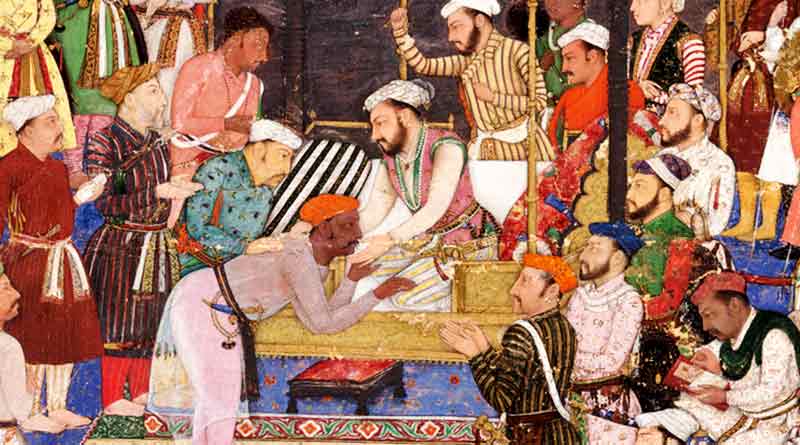 A painting portraying the Mughal Empire in India. Image Source
A painting portraying the Mughal Empire in India. Image Source
Mughal Sultans:
- Babur (1526-1530)
- Humayun (1530-1540 and 1555-1556)
- Akbar (1556-1605)
- Jahangir (1605-1627)
- Shah Jahan (1628-1658)
- Aurangzeb (1658-1707)
- Muhammad Shah (1719-48)
- Bahadur Shah II (1837-1857)
The Rise of the Mughal Empire:
In 1526 a Turkic Prince, Babur (who was a descendent of the Turkic conqueror, Timur, and the Mongol ruler, Genghis Khan), set out to take control over the Punjab region in India. From his base in Kabul, Afghanistan, Babur took control of the Punjab region and was able to defeat Ibrahim Lodi, the Delhi Sultan.[5] This battle is known as the First Battle of Panipat. Babur’s thirst for the conquest of India is said to have been inspired by Timur’s raids on India during the 14th century.[6] Babur military success is significantly owned to his use of firearms and the superiority and experience of his cavalry.[7] Consequently, by Babur’s death in 1530, the Mughal’s controlled most of Northern India.[8]
After Babur’s death his son, Humayun reigned over the Mughal Empire. However, by 1540 he lost control over the region to Afghan rebels and was sent to exile by the Afghan ruler, Sher Shah Sur.[9] In 1555, with the help of the Persians and his son, Akbar, who defeated Hemu (a Hindu usurper) at the Second Battle of Panipat in 1556, the Moghul Empire was re-established.[10] Akbar took control over the empire after his father’s death in 1556. He was to become known as Akbar the Great and considered as the greatest Mughal emperor.[11] It was under his reign that the Mughal Empire started to reach its full potential. During Akbar’s control, the Mughal Empire expanded from “Kashmir in the north and Afghanistan in the northwest to Bengal in the east and the Deccan plateau in the south”.[12] Akbar also implemented significant political, military and administrative structures that were used for generations to come.[13]
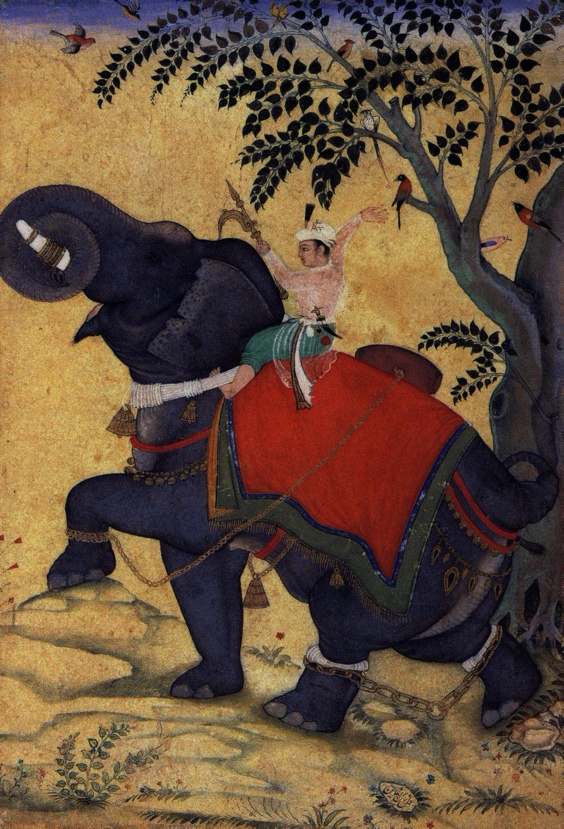 A painting of Akbar the Great training an elephant.Image Source
A painting of Akbar the Great training an elephant.Image Source
Government and Society:
During Akbar’s rule (1556-1605) significant political, administrative and military changes were made to the existing structures of the Mughal Empire. Akbar decided to impose a centralized system of administration and governance, where mansabdars (warrior-aristocrats) could be appointed to rule from various bureaucratic or military positions.[14] This system of governance was also accompanied by religious tolerance where people from various religious or cultural backgrounds could enlist and take part in the military or government services.[15] Furthermore, Akbar decided to abolish the poll tax that non-Muslims had to pay and he refused to attempt to convert his region’s Hindu population to Islam.[16] The decision for tolerance and openness to other religions played a significant role in the attempt to unite the different regions of his empire, as it ensured loyalty and a sense of coexistence among the different cultural and religious groups.[17] This was highly important for the Mughal Empire’s survival and reign as the majority of the empire were citizens who followed the Hindu faith.[18] Furthermore, these changes ensured the empire’s survival for another century and also led to various cultural and artistic revolutions.[19]
Role of Women:
In Indian society men usually had the political and economic power, where women were usually regarded as inferior.[20] Women who formed a part of the nobility or were of wealthier backgrounds were usually kept out of the public eye and housed in separate areas called harems.[21] However, it should be noted that during the Mughal rule, the Sultan’s wives were usually highly respected and some were encouraged and free to receive or seek education.[22] Some of the women who formed a part of the nobility attempted to help other women from poorer communities by giving them financial aid as these women were reduced to the control of their husbands and were forced to work in the rural areas.[23] One of the most influential women from the Moghul Empire is Meher-un-Nissa (commonly known as Nur Jahan), the wife of Jahangir (the son of Akbar the Great), who in many cases considered her as his equal.[24] Nur Jahan, for example, started various campaigns that attempted to support disadvantaged citizens of the empire.[25]
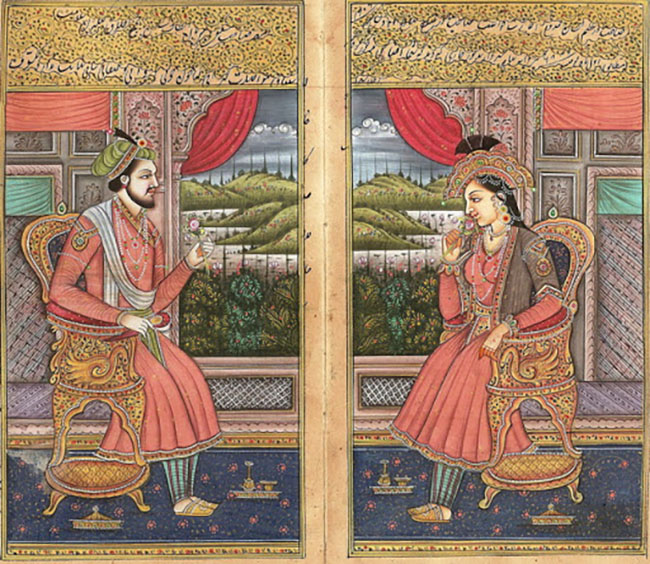 A portrait of Shah Jehan and his wife, Mumtaz Mahal. The pair are painted as equals. Image Source
A portrait of Shah Jehan and his wife, Mumtaz Mahal. The pair are painted as equals. Image Source
Architecture and the Arts:
Humayun’s Period: After Humayun’s exile (1540-1555) in Persia, he was accompanied back to India by a famous Persian painter named Mir Sayid Ali.[26] Shortly after Humayun’s death, under the reign of Akbar, Mir Sayid Ali and other Persian painters brought to India by Humanyun, established the first Moghul painting studio in Fatehpur Sikri.[27] After this establishment, Mughal paintings started to revolutionize into a distinctive style that combined sophisticated Persian painting techniques with the rich and bold colours used by local Indian painters and artists.[28] Although Humayun’s influence on the arts was shortly lived due to his lengthy exile and timely death, his tomb in Delhi is considered as an early symbol of Moghul architecture, that showcased elements of large domes, slender minarets and large decorated gateways.[29]
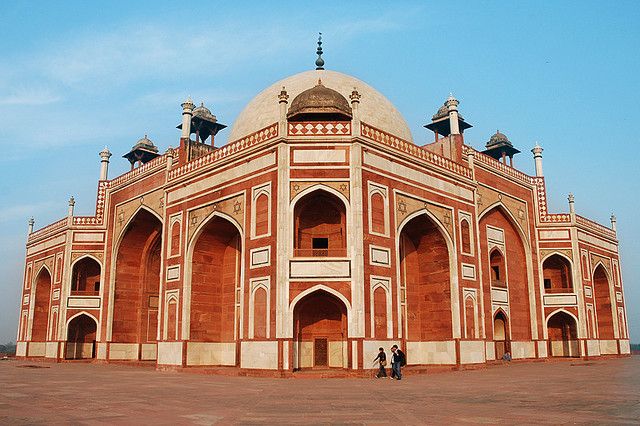 Humayun’s tomb in Delhi, India. Image Source
Humayun’s tomb in Delhi, India. Image Source
Akbar’s Period: Although Akbar’s reign is best known for the effectiveness of his changes in administrative and military structures of his empire, Akbar also had significant influences on the cultural and artistic aspects of the Mughal Empire. For example, Akbar decided to build ibadar-khana (a “house of worship”) near his palace in Agra, where debates with various cultural or religious representation could be hosted.[30] Furthermore, Akbar hosted various intellectuals, poets, musicians, philosophers and engineers in his various courts across Delhi, Agra and Fatehphur Sikri.[31] Significantly, it is during Akbar’s reign that a Mughal architectural style developed – this style is known for its combination of Islamic, Persian and Hindu elements of design.[32]
An interesting note of the development of art during Akbar’s rule, is his encouragement of portraiture. This is interesting because portraiture was considered taboo as a form or art by the Islamic faith because it is contrary to Koranian faith.[33] However, with Akbar’s openness to various cultural and religious expressions, he described to his courtiers that although, "There are many people who despise painting: I myself cannot abide this type of person. I feel that painters are endowed with exceptional means of knowing God; a painter in drawing a living person is forced to admit that he is unable to bring his subject to life. He is led to think of God as the sole creator of all life, and in this way learns to know Him better".[34] Consequently, with Akbar’s influence and encouragement, portraiture became a significant aspect in the Mughal school of art and was commonly associated with the rich.
Shah Jahan’s Period: Shah Jahan was commonly known for his “insatiable passion” for architecture and the time of his rule is considered the cultural zenith of the Mughal Empire.[35] In fact the famed Taj Mahal (which was named “the jewel of Muslim art in India” by UNESCO World Heritage and declared one of the ‘New 7 Wonders of the World’) was built for his late wife, Mumtaz Mahal, who died during childbirth.[36] It is also during Shah Juhan’s reign when the Red Fort in Delhi was built.[37] Although Shah Jahan’s passion for architecture was unquenchable, he did not share the same thirst for art and paintings and therefore, during Shah Jahan’s rule there were very few significant additions to Mughal art.[38]
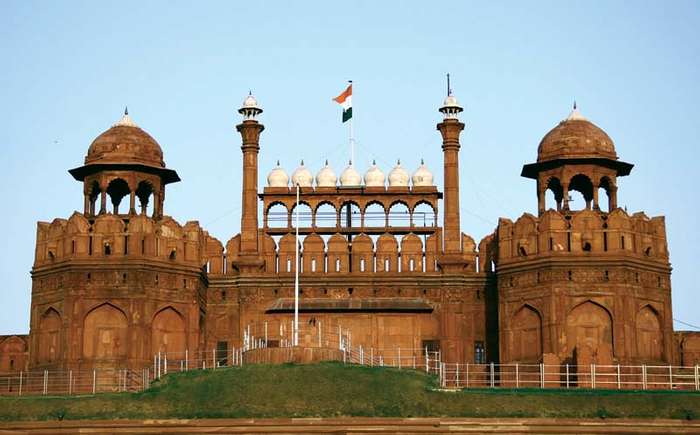 The Red Fort in Delhi that was built during Shah Jahan’s rule over Mughal India. Image Source
The Red Fort in Delhi that was built during Shah Jahan’s rule over Mughal India. Image Source
Aurangzeb’s Period: Although Aurangzeb’s period of rule marked a broad expansion of the Mughal Empire through various annexations (for example: the Deccan Kingdoms of Vijayapura and Golconda), this period was also marked with the drastic decline of the Mughal Empire (the reasons and factors for the Mughal decline will be thoroughly discussed in the last section, ‘the decline of the Mughal Empire).[39] Aurangzeb’s rule and personality was characterized by highly orthodoxic practices within the Muslim religion.[40] This meant that most luxuries such as music and art were banned in court.[41] Furthermore, various schools, temples, works of art and especially portraits were destroyed. Consequently, many artists fled the capital and took refuge in various local courts.[42]
Astronomy and Technology:
Due to the openness and encouragement of various subjects such as art, literature and engineering from different cultures and regions under Akbar’s rule, the Mughal Empire experienced an epicenter of academic discussion and learning.[43] In fact, it was Indian scientists who invented the concept of zero – which revolutionized modern mathematics.[44] Furthermore, Indian metallurgists (people who work with and reshape melted metal) invented the metal seamless celestial globe which aided astronomers to map the various stars and constellations.[45] Remarkably, these globes were completely seamless and only 21 of globes were made. Modern scientists and technology are unable to reproduce the same seamless metal globes.[46]
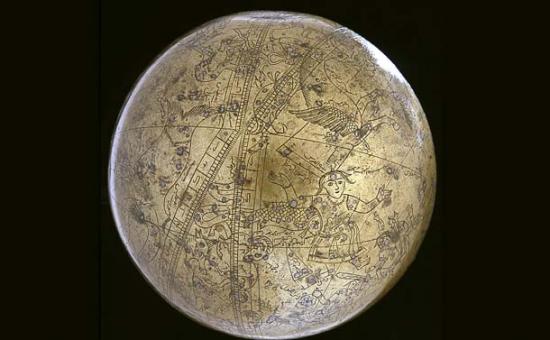 A metal celestial globe made during Akbar’s rule of the Mughal Empire.Image Source
A metal celestial globe made during Akbar’s rule of the Mughal Empire.Image Source
Travel and Trade:
During the Mughal Empire, Indian trade became a significant player in world trade. Various European companies (especially Portugal and Great Britain) sought to dominate Indian Trade.[47] In 1700 English merchants established the English East India Company that traded from main ports incentres such as Madras, Bombay and Calcutta.[48] However, before European dominance in the later centuries, India’s trade flourished under certain principles. For example, each village had its own smaller markets whose commodities reached large ports.[49] Furthermore, there was a great extent of professionalism among Moghul Indian traders who specialized in various trades (most notably the production and trading of cotton and silk).[50] Towards the end of the 17th century, Indian textile exports dominated more than 25% of the world’s market share.[51]
The Decline of the Mughal Empire:
The beginning of the Mughal Empire’s decline started to show during the reign of Sultan Shah Jahan. Due his excessive building and some of his military expansions, the empire started to show some signs of bankruptcy.[52] After Shah Juhan’s death, his youngest son, Aurangzeb conquered the throne by eliminating his brothers.[53] As briefly mentioned, Aurangzeb’s rule was categorized by the strict following of Islam. Therefore, Aurangzeb demolished the enlightenment that followed Akbar’s rule, by eliminating almost all tolerance of the Hindu religion.[54] This was done through excluding all Hindus from governance and public offices, as well as the persecution of the Sikhs and Punjab.[55] Consequently, hope for a continued united Indian state - which was created by decades of mutual religious and cultural tolerance and acceptance during Akbar, Jahangir and Shah Jahan’s reign – was lost. This also meant that certain regions that followed other religion started questioning Aurangzeb’s, and the Rajputs, Sikhs and Marathas launched various rebellions against the Moghul Empire.[56] By Aurangzeb’s death in 1707, the Marathas controlled authority in most of the Mughal regions.
Aurangzeb’s death marked the Mughal Empire with a period of abrupt and inconsistent lapses of Mughal control. For example, only in 1719 did Muhammad Shah take control over a now fragmented empire that was experiencing numerous dynastic warfare and internal rivalries.[57] However, in 1739 the Mughals lost control once more with Iranian conqueror, Nadir Shah’s launch of a disruptive invasion on northern India, where his military sacked Delhi and took control over various Mughal treasures.[58] This victory over the once powerful Mughals highlighted the lapse in their power and vulnerability in their rule. Consequently, the Mughal Empire was reduced to a small region near Delhi.[59] After various exchanges of control over this small region between the Mughals, the Marathas and even the British imperial rule, the last of the Mughal leaders, Bahadur Shah II, took control of the region – only to be exiled by the British after the Mughal’s involvement in the Indian Mutiny of 1857-1858.[60] It became evident that the Mughals were unable to retain their power and compete with the strong internal forces, as well as the now ever growing European imperial and colonial influence and power.
This content was originally produced for the SAHO classroom by
Ilse Brookes, Amber Fox-Martin & Simone van der Colff
End Notes
[1] Author Unknown, “The Age of the Mughals,” Victoria and Albert Museum [online], available at http://www.vam.ac.uk/content/articles/a/the-age-of-the-mughals/ (Accessed: 20 June 2020).
[2] Author Unknown, “Mughal Empire,” Britannica [online], available at https://www.britannica.com/topic/Mughal-dynasty (Accessed: 20 June 2020).
[3] Author Unknown, “Mughal Dynasty,” Britannica [online], available at https://www.britannica.com/topic/Mughal-dynasty (Accessed: 20 June 2020).
[4] Author Unknown, “Mughal Dynasty,” Britannica [online], available at https://www.britannica.com/topic/Mughal-dynasty (Accessed: 20 June 2020).
[5] Author Unknown, “Mughal Dynasty,” Britannica [online], available at https://www.britannica.com/topic/Mughal-dynasty (Accessed: 20 June 2020).
[6] Author Unknown, “The Age of the Mughals,” Victoria and Albert Museum [online], available at http://www.vam.ac.uk/content/articles/a/the-age-of-the-mughals/ (Accessed: 20 June 2020).
[7] A. Hart-Davis, History: Definitive Visual Guide, Dorling Kindersley Limited, Great Britain, 2007, p. 244.
[8] Author Unknown, “Mughal Dynasty,” Britannica [online], available at https://www.britannica.com/topic/Mughal-dynasty (Accessed: 20 June 2020).
[9] A. Hart-Davis, History: Definitive Visual Guide, Dorling Kindersley Limited, Great Britain, 2007, p. 244.
[10] Author Unknown, “Mughal Dynasty,” Britannica [online], available at https://www.britannica.com/topic/Mughal-dynasty (Accessed: 20 June 2020).
[11] Author Unknown, “Mughal Dynasty,” Britannica [online], available at https://www.britannica.com/topic/Mughal-dynasty (Accessed: 20 June 2020).
[12] A. Hart-Davis, History: Definitive Visual Guide, Dorling Kindersley Limited, Great Britain, 2007, p. 244.
[13] Author Unknown, “Mughal Dynasty,” Britannica [online], available at https://www.britannica.com/topic/Mughal-dynasty (Accessed: 20 June 2020).
[14] A. Hart-Davis, History: Definitive Visual Guide, Dorling Kindersley Limited, Great Britain, 2007, p. 244.
[15] Author Unknown, “Mughal Dynasty,” Britannica [online], available at https://www.britannica.com/topic/Mughal-dynasty (Accessed: 20 June 2020).
[16] Author Unknown, “Akbar the Great,” Biography [online], available at https://www.biography.com/political-figure/akbar-the-great (Accessed: 22 June 2020).
[17] Author Unknown, “Akbar the Great,” Biography [online], available at https://www.biography.com/political-figure/akbar-the-great (Accessed: 22 June 2020).
[18] A. Hart-Davis, History: Definitive Visual Guide, Dorling Kindersley Limited, Great Britain, 2007, p. 245.
[19] Author Unknown, “Mughal Dynasty,” Britannica [online], available at https://www.britannica.com/topic/Mughal-dynasty (Accessed: 20 June 2020).
[20] J. Bottaro & P. Visser & N. Worden, Oxford in Search of History: Grade 1o Learner’s Book, Oxford University Press, South Africa.
[21] J. Bottaro & P. Visser & N. Worden, Oxford in Search of History: Grade 1o Learner’s Book, Oxford University Press, South Africa.
[22] M. Fatima, “Powerful Women of the Mughal Empire,” Youlin Magazine: A Cultural Journal [online], available at https://www.youlinmagazine.com/article/powerful-women-of-the-mughal-empire/MTY5Nw== (Accessed: 22 June 2020).
[23] J. Bottaro & P. Visser & N. Worden, Oxford in Search of History: Grade 1o Learner’s Book, Oxford University Press, South Africa.
[24] M. Fatima, “Powerful Women of the Mughal Empire,” Youlin Magazine: A Cultural Journal [online], available at https://www.youlinmagazine.com/article/powerful-women-of-the-mughal-empire/MTY5Nw== (Accessed: 22 June 2020).
[25] M. Fatima, “Powerful Women of the Mughal Empire,” Youlin Magazine: A Cultural Journal [online], available at https://www.youlinmagazine.com/article/powerful-women-of-the-mughal-empire/MTY5Nw== (Accessed: 22 June 2020).
[26] Author Unknown, “Mughal Painting, India,” Visual Arts [online], available at http://www.visual-arts-cork.com/east-asian-art/mughal-painting.htm (Accessed: 22 June 2020).
[27] Author Unknown, “Mughal Painting, India,” Visual Arts [online], available at http://www.visual-arts-cork.com/east-asian-art/mughal-painting.htm (Accessed: 22 June 2020).
[28] Author Unknown, “The Age of the Mughals,” Victoria and Albert Museum [online], available at http://www.vam.ac.uk/content/articles/a/the-age-of-the-mughals/ (Accessed: 20 June 2020).
[29] Author Unknown, “The Mughals,” UCF Web courses [online], available at https://webcourses.ucf.edu/courses/1274391/pages/the-mughals (Accessed: 22 June 2020).
[30] A. Hart-Davis, History: Definitive Visual Guide, Dorling Kindersley Limited, Great Britain, 2007, p. 245.
[31] Author Unknown, “Akbar the Great,” Biography [online], available at https://www.biography.com/political-figure/akbar-the-great (Accessed: 22 June 2020).
[32] Author Unknown, “Akbar the Great,” Biography [online], available at https://www.biography.com/political-figure/akbar-the-great (Accessed: 22 June 2020).
[33] Author Unknown, “Mughal Painting, India,” Visual Arts [online], available at http://www.visual-arts-cork.com/east-asian-art/mughal-painting.htm (Accessed: 22 June 2020).
[34] Author Unknown, “Mughal Painting, India,” Visual Arts [online], available at http://www.visual-arts-cork.com/east-asian-art/mughal-painting.htm (Accessed: 22 June 2020).
[35] Author Unknown, “Mughal Dynasty,” Britannica [online], available at https://www.britannica.com/topic/Mughal-dynasty (Accessed: 20 June 2020).
[36] Author Unknown, “Mughal Dynasty,” Britannica [online], available at https://www.britannica.com/topic/Mughal-dynasty (Accessed: 20 June 2020).
[37] J. Bottaro & P. Visser & N. Worden, Oxford in Search of History: Grade 1o Learner’s Book, Oxford University Press, South Africa.
[38] Author Unknown, “Mughal Painting, India,” Visual Arts [online], available at http://www.visual-arts-cork.com/east-asian-art/mughal-painting.htm (Accessed: 22 June 2020).
[39] Author Unknown, “Mughal Dynasty,” Britannica [online], available at https://www.britannica.com/topic/Mughal-dynasty (Accessed: 20 June 2020).
[40] Author Unknown, “Mughal Painting, India,” Visual Arts [online], available at http://www.visual-arts-cork.com/east-asian-art/mughal-painting.htm (Accessed: 22 June 2020).
[41] Author Unknown, “Mughal Painting, India,” Visual Arts [online], available at http://www.visual-arts-cork.com/east-asian-art/mughal-painting.htm (Accessed: 22 June 2020).
[42] Author Unknown, “Mughal Painting, India,” Visual Arts [online], available at http://www.visual-arts-cork.com/east-asian-art/mughal-painting.htm (Accessed: 22 June 2020).
[43] J. Bottaro & P. Visser & N. Worden, Oxford in Search of History: Grade 1o Learner’s Book, Oxford University Press, South Africa.
[44] J. Bottaro & P. Visser & N. Worden, Oxford in Search of History: Grade 1o Learner’s Book, Oxford University Press, South Africa.
[45] J. Bottaro & P. Visser & N. Worden, Oxford in Search of History: Grade 1o Learner’s Book, Oxford University Press, South Africa.
[46] J. Bottaro & P. Visser & N. Worden, Oxford in Search of History: Grade 1o Learner’s Book, Oxford University Press, South Africa.
[47] J. Bottaro & P. Visser & N. Worden, Oxford in Search of History: Grade 1o Learner’s Book, Oxford University Press, South Africa.
[48] J. Bottaro & P. Visser & N. Worden, Oxford in Search of History: Grade 1o Learner’s Book, Oxford University Press, South Africa.
[49] Author Unknown, “Inland and Foreign Trade during the Mughal Period,” History Discussion [online], available at https://www.historydiscussion.net/history-of-india/inland-and-foreign-trade-during-the-mughal-period/2832 (Accessed: 22 June 2020).
[50] Author Unknown, “Inland and Foreign Trade during the Mughal Period,” History Discussion [online], available at https://www.historydiscussion.net/history-of-india/inland-and-foreign-trade-during-the-mughal-period/2832 (Accessed: 22 June 2020).
[51] Author Unknown, “Inland and Foreign Trade during the Mughal Period,” History Discussion [online], available at https://www.historydiscussion.net/history-of-india/inland-and-foreign-trade-during-the-mughal-period/2832 (Accessed: 22 June 2020).
[52] Author Unknown, “Mughal Dynasty,” Britannica [online], available at https://www.britannica.com/topic/Mughal-dynasty (Accessed: 20 June 2020).
[53] Author Unknown, “Mughal Painting, India,” Visual Arts [online], available at http://www.visual-arts-cork.com/east-asian-art/mughal-painting.htm (Accessed: 22 June 2020).
[54] Author Unknown, “Mughal Dynasty,” Britannica [online], available at https://www.britannica.com/topic/Mughal-dynasty (Accessed: 20 June 2020).
[55] Author Unknown, “Mughal Dynasty,” Britannica [online], available at https://www.britannica.com/topic/Mughal-dynasty (Accessed: 20 June 2020).
[56] Author Unknown, “Mughal Dynasty,” Britannica [online], available at https://www.britannica.com/topic/Mughal-dynasty (Accessed: 20 June 2020).
[57] Author Unknown, “Mughal Dynasty,” Britannica [online], available at https://www.britannica.com/topic/Mughal-dynasty (Accessed: 20 June 2020).
[58] A. Hart-Davis, History: Definitive Visual Guide, Dorling Kindersley Limited, Great Britain, 2007, p. 245.
[59] Author Unknown, “Mughal Dynasty,” Britannica [online], available at https://www.britannica.com/topic/Mughal-dynasty (Accessed: 20 June 2020).
[60] Author Unknown, “Mughal Dynasty,” Britannica [online], available at https://www.britannica.com/topic/Mughal-dynasty (Accessed: 20 June 2020).